How to Clean Baby Bottles Without Plastic Toxins: Safe & Natural Methods
As a parent, one of your biggest responsibilities is ensuring your baby’s health and safety, starting with something as simple—but crucial—as feeding time. That’s why many new moms and dads are searching for the best ways on how to clean baby bottles without plastic toxins. The concern is real: studies show that common plastics can release harmful chemicals like BPA, phthalates, and even microplastics when exposed to heat or harsh cleaning methods. Since infants are especially sensitive to these toxins, knowing how to wash and sterilize bottles safely is essential for peace of mind.
In this guide, we’ll break down the hidden dangers of standard cleaning methods, share non-toxic alternatives, and give you a complete, step-by-step routine to keep your baby bottles safe, hygienic, and free from plastic contamination.
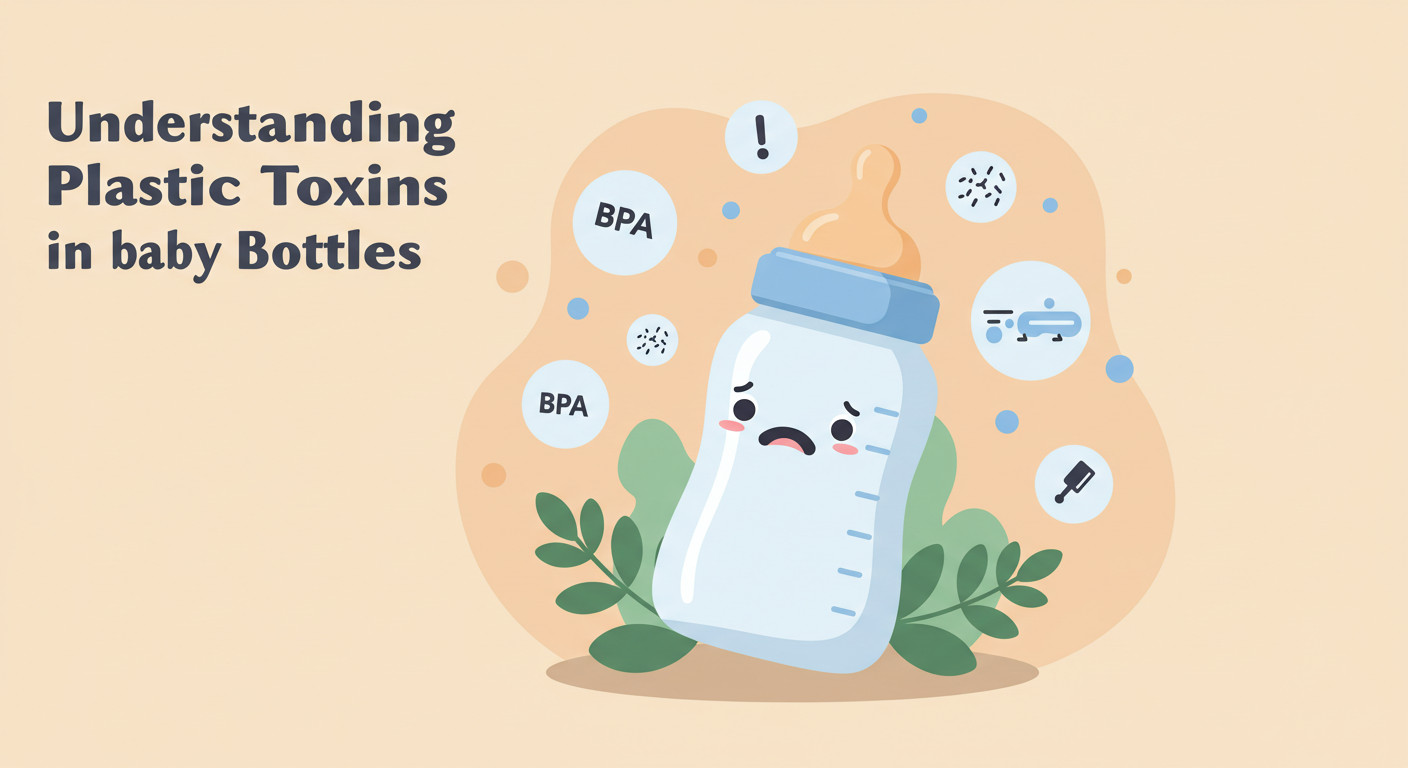
2. Understanding Plastic Toxins in Baby Bottles
When it comes to baby feeding, many parents focus on cleanliness but overlook a critical aspect: what the bottles are made of and how they interact with cleaning and sterilization. Understanding plastic toxins is foundational to knowing why safe cleaning methods matter.
2.1 What Are the Suspected Plastic Toxins?
-
Bisphenol A (BPA): A well-known endocrine disruptor, BPA can mimic estrogen and interfere with hormone function. Many governments have restricted BPA use in baby bottles, but similar compounds like BPS or BPF may carry similar risks.
-
Phthalates: These chemicals are often used to make plastics more flexible. In some types of plastic (like #3 PVC), phthalates can leach out, especially under heat or stress.
-
Microplastics & Nanoplastics: Tiny plastic particles — sometimes microscopic — that shed off the surface or degrade over time, especially under high temperature or mechanical stress.
-
Other Additives / Plasticizers: Including stabilizers, dyes, antioxidants, etc., which may release trace compounds when plastics degrade.
2.2 How Toxins Can Leach into Milk or Formula
-
Frequent exposure to heat, friction, or strong cleaning agents can degrade the polymer matrix, causing microplastic shedding or chemical leaching.
-
A landmark study found that cleaning and sterilization steps on polypropylene baby bottles may release up to 16.2 million microplastic particles per liter when formula is being prepared. Food Packaging Forum
-
Another review noted that infants might be exposed to higher levels of microplastics via plastic feeding bottles, toys, formula containers, and even breastmilk contamination. PMC
-
In one experimental setup, polypropylene (PP) baby bottles released up to ~16,200 microplastic particles per milliliter after heat treatment. PMC
2.3 Why Infants Are More Vulnerable
-
Babies have underdeveloped detoxification systems, making them less able to process and eliminate harmful compounds.
-
Their organs — especially the brain and endocrine (hormone) systems — are still developing, making them more susceptible to low-level exposures.
-
Studies link exposure to endocrine-disrupting compounds in early life with possible long-term effects: metabolic issues, hormonal imbalances, neurodevelopmental concerns.
-
One research on irregular microplastic shards (not just spherical particles) from feeding bottles showed they could provoke inflammatory responses in human intestinal cells (Caco-2). PubMed
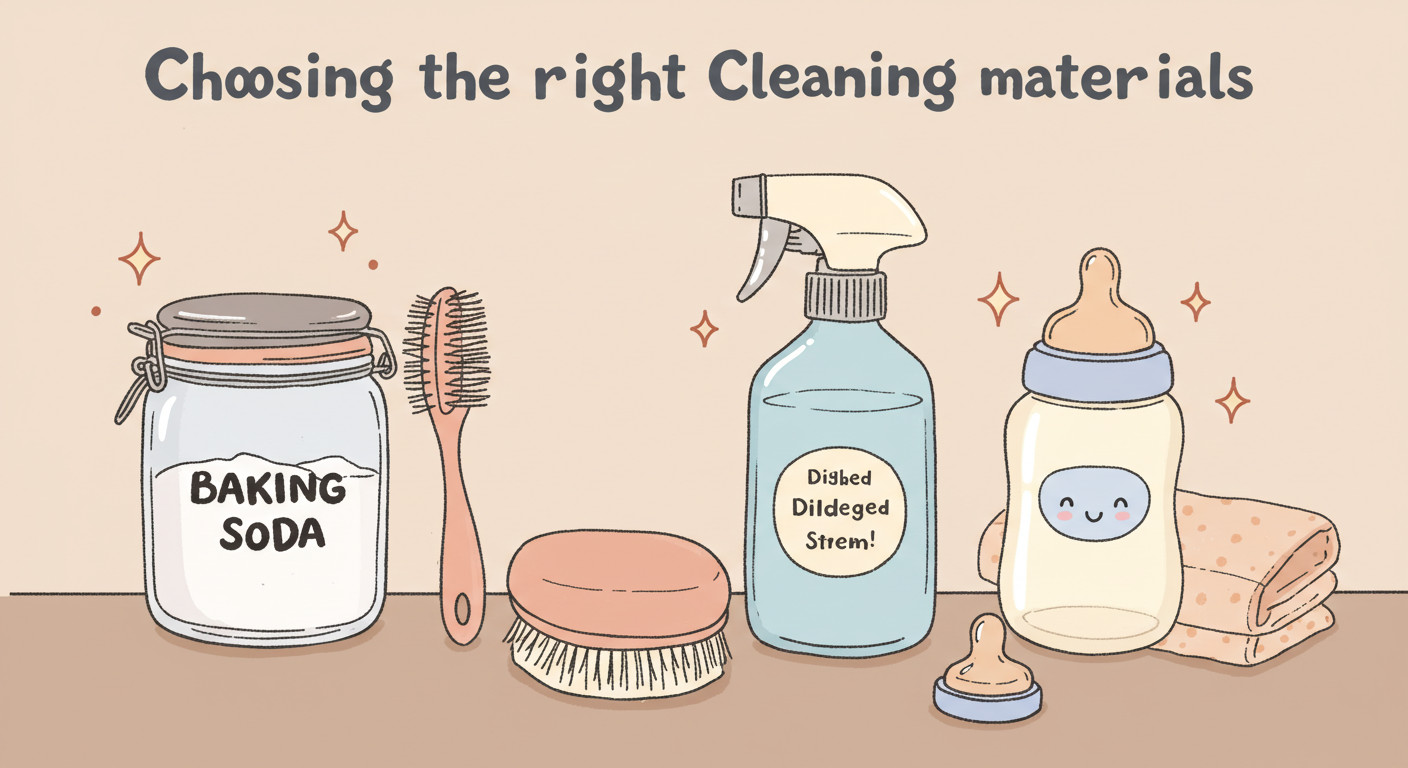
3. Choosing the Right Cleaning Materials
Once you understand the risks of plastic toxins, the next step is choosing the safest tools and cleaners for your baby bottles. The right materials protect your baby while keeping bottles spotless and hygienic.
3.1 Non-Toxic Cleaning Agents Every Parent Can Trust
-
Baking Soda (Sodium Bicarbonate): It neutralizes odors, removes milk residue, and gently scrubs without damaging the surface.
-
White Vinegar: Its natural acidity helps dissolve mineral deposits and eliminate bacteria. Dilute it in water (1 part vinegar, 3 parts water) for safe use.
-
Hydrogen Peroxide (3% Solution): It disinfects without leaving harmful residues. Rinse well after use.
-
Fragrance-Free, Baby-Safe Dish Soap: Choose mild formulas that avoid dyes, perfumes, or harsh chemicals.
3.2 Safe Tools That Keep Bottles Scratch-Free
-
Soft Bottle Brushes: Nylon or silicone brushes clean well without scratching. Scratches trap bacteria and accelerate microplastic shedding.
-
Microfiber Cloths: These wipe gently and dry bottles without lint.
-
Silicone Bottle Washers or Sponges: They bend easily, reach tight corners, and don’t damage the surface.
3.3 What You Should Avoid
-
Bleach or Harsh Chemicals: These can break down plastics and leave dangerous residues.
-
Abrasive Sponges or Metal Brushes: They scratch plastic, creating hotspots for microplastic release.
-
Strong Detergents with Perfume or Colorants: They contain unnecessary chemicals that linger inside the bottle.
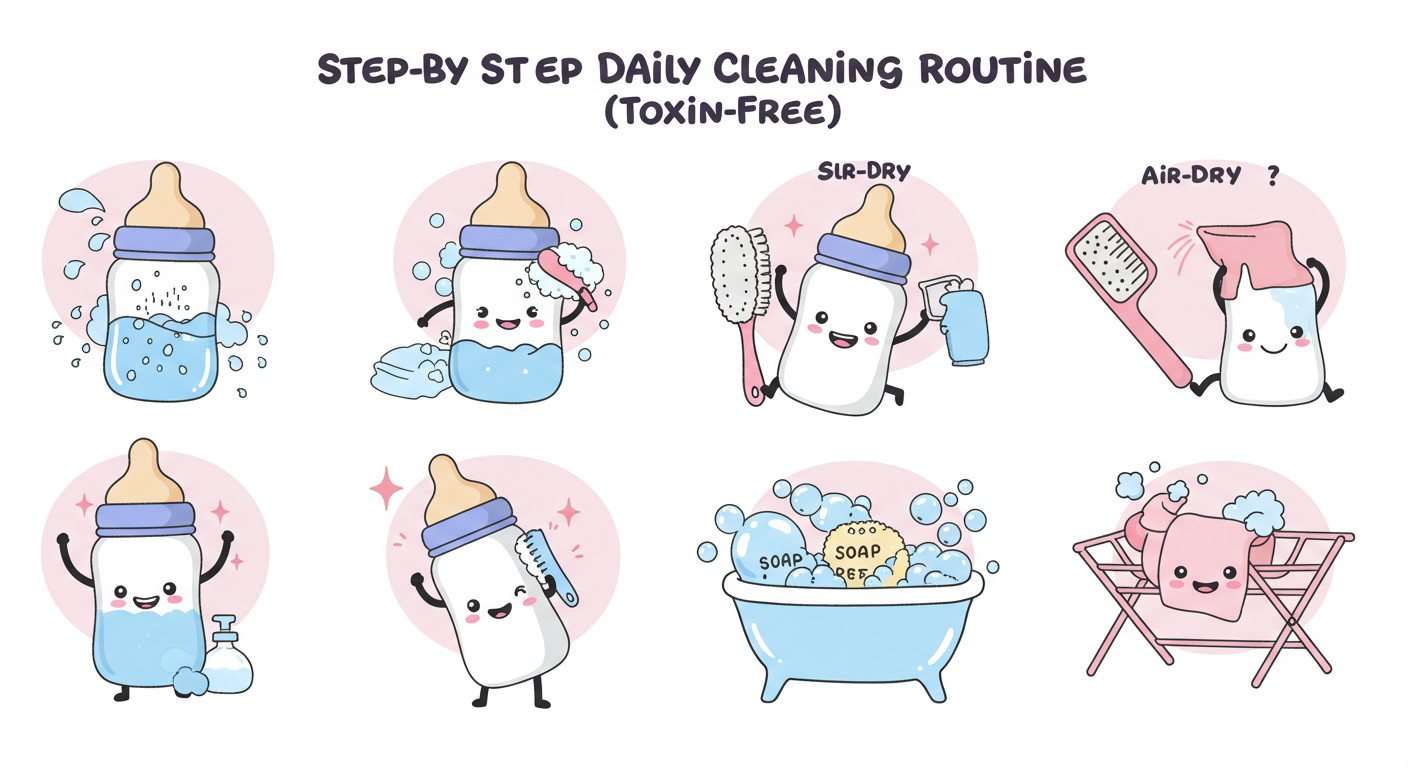
4. Step-by-Step Daily Cleaning Routine (Toxin-Free)
Parents often feel overwhelmed by the endless cycle of washing baby bottles. A simple, toxin-free daily routine keeps bottles clean, safe, and ready for the next feeding—without exposing your baby to harmful plastics. Follow these steps consistently, and you’ll reduce both germs and chemical risks.
4.1 Rinse Immediately
As soon as your baby finishes feeding, rinse the bottle with warm (not boiling) water. This quick step removes leftover milk before it hardens and prevents bacteria from growing.
4.2 Wash with Mild Soap and a Soft Brush
Fill the bottle with warm water and add a small amount of baby-safe dish soap. Use a silicone or nylon bottle brush to scrub the inside thoroughly. Clean the nipple, collar, and cap separately to ensure no residue remains.
4.3 Rinse Thoroughly
Detergent residue can cling to plastic, especially if the bottle has fine scratches. Rinse each piece under running water until no soap bubbles remain. Always double-check the nipple holes to make sure nothing clogs them.
4.4 Dry Naturally
Place bottles upside down on a clean drying rack. Let them air-dry instead of wiping with a cloth, because cloth fibers can introduce bacteria or scratch the surface. Avoid sealing bottles while still wet, since trapped moisture encourages mold.
4.5 Store Safely
Once dry, keep bottles in a clean, closed container or covered drying rack. Store them away from direct sunlight, which can degrade plastic faster and release microplastics.
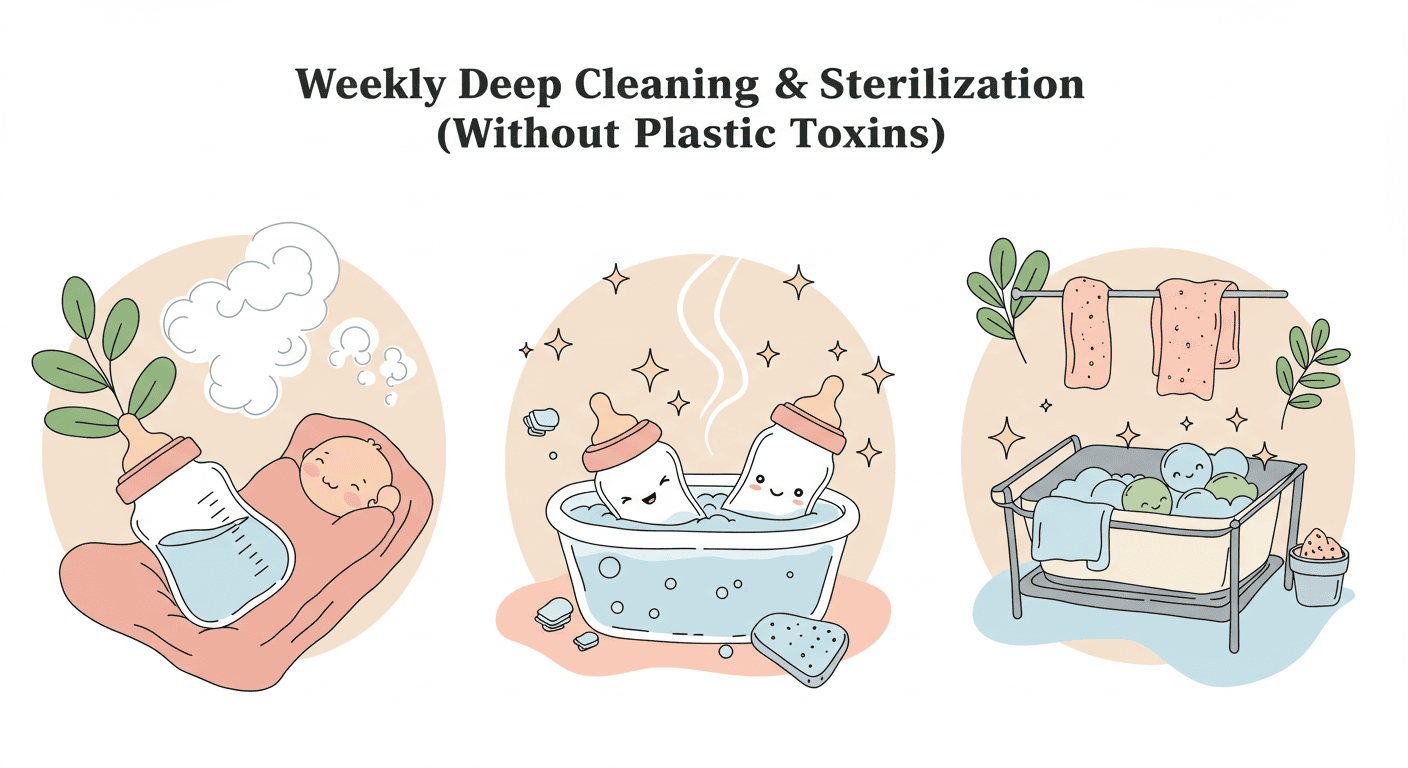
5. Weekly Deep Cleaning & Sterilization (Without Plastic Toxins)
Daily cleaning keeps bottles fresh, but babies need an extra layer of protection. A weekly deep cleaning and sterilization routine eliminates stubborn bacteria without triggering harmful plastic breakdown.
5.1 Boiling: Use with Care
Boiling works for glass or stainless steel bottles, but it’s risky for plastic. High heat speeds up microplastic shedding and chemical leaching. If you must boil a plastic bottle, limit exposure to a few minutes and replace bottles often.
5.2 Steam Sterilizers
A safer option is a steam sterilizer designed for baby bottles. These devices use high-temperature steam inside a contained unit, which disinfects effectively while reducing direct plastic contact with boiling water. Always choose models with glass or stainless inserts when possible.
5.3 Cold-Water Sterilizing Solutions
Many parents in the U.S. prefer chlorine-free cold-water sterilizing tablets or liquids. They disinfect bottles in about 30 minutes and don’t rely on heat. Choose solutions made specifically for baby products to avoid hidden chemicals.
5.4 Natural Disinfection Methods
-
Hydrogen Peroxide (3%): Soak bottles in a diluted solution for 10–15 minutes, then rinse thoroughly.
-
Vinegar Rinse: Mix equal parts water and vinegar, soak for 20 minutes, and rinse with warm water.
-
Sunlight Exposure: Place clean bottles under direct sunlight for a natural antibacterial boost.
5.5 Weekly Routine at a Glance
-
Do your regular cleaning first.
-
Pick a safe sterilization method (steam, cold-water, or natural).
-
Rinse well to remove any residues.
-
Let bottles air-dry completely before storage.
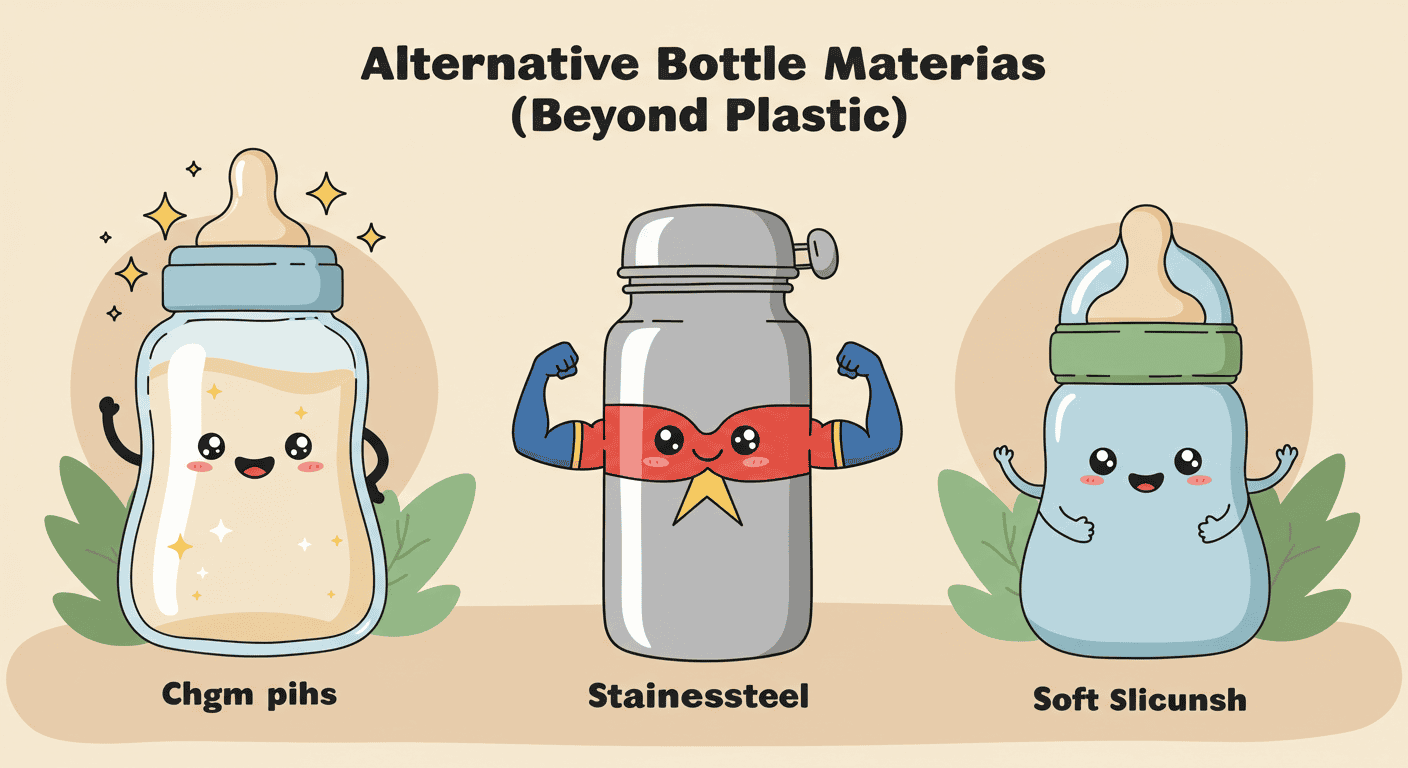
6. Alternative Bottle Materials (Beyond Plastic)
Parents who want to avoid plastic toxins altogether often switch to safer alternatives. Choosing the right material not only reduces chemical exposure but also improves the durability and safety of your feeding routine.
6.1 Glass Bottles
Glass bottles remain the gold standard for safety. They don’t leach toxins, they clean easily, and they withstand high heat during sterilization. The downside is their weight and the risk of breakage, but many brands now add silicone sleeves to make them more durable.
6.2 Stainless Steel Bottles
Stainless steel offers lightweight strength and long-lasting use. It doesn’t absorb odors, resists scratches, and handles boiling water without releasing toxins. However, you can’t see the liquid level inside, so some parents find them less convenient for quick feeds.
6.3 Silicone Bottles
Food-grade silicone bottles combine flexibility with safety. They resist heat well, don’t crack like glass, and feel soft for babies to hold. Still, not all silicone bottles are created equal—always choose medical-grade or FDA-approved silicone to ensure purity.
6.4 How to Choose the Right Alternative
-
If you prioritize safety and purity → go with glass.
-
If you want durability and portability → pick stainless steel.
-
If you need lightweight flexibility → choose silicone.
Switching to these alternatives may require an upfront investment, but the long-term health benefits for your baby make it worthwhile.
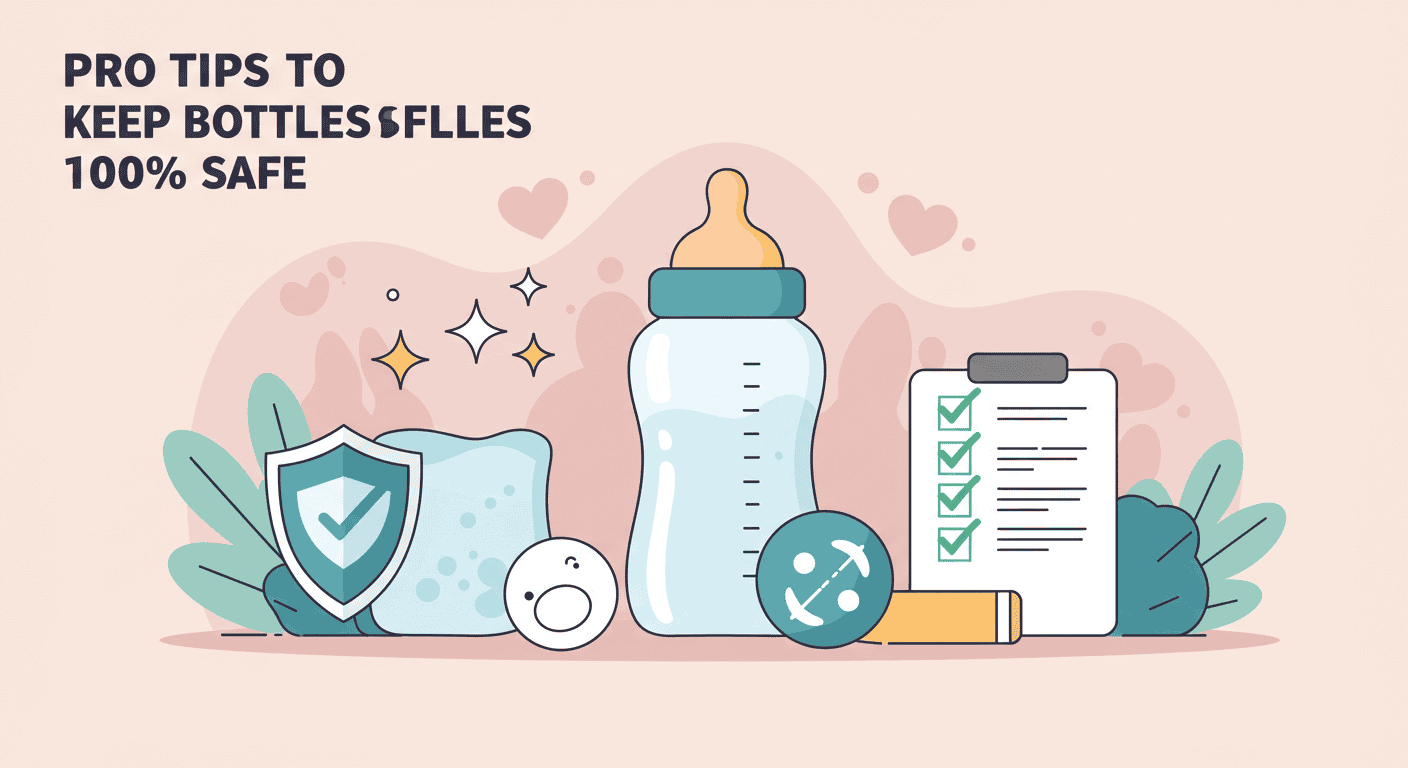
7. Pro Tips to Keep Bottles 100% Safe
Even with the right cleaning routine, small details can make a big difference in keeping your baby bottles safe and toxin-free. These pro tips help you maximize hygiene while minimizing chemical risks.
7.1 Replace Bottles Regularly
Plastic bottles wear out over time. Replace them every few months or as soon as you notice scratches, cloudiness, or discoloration. Damaged bottles release more microplastics and harbor bacteria in tiny grooves.
7.2 Avoid Extreme Temperatures
Never pour boiling water directly into a plastic bottle. Heat accelerates chemical leaching and weakens the material. Instead, prepare formula in a separate container, let it cool slightly, and then transfer it.
7.3 Rotate Bottles in Use
Don’t rely on just one or two bottles. Rotating a set of four to six bottles reduces wear and tear, extending their lifespan and lowering exposure risks.
7.4 Follow Manufacturer Guidelines
Every brand tests bottles under specific conditions. Always follow instructions for washing, sterilizing, and replacement. Using methods not recommended by the manufacturer can void safety claims.
7.5 Store Bottles the Smart Way
Keep bottles in a clean, dry, covered space. Avoid leaving them in direct sunlight or damp environments like under the sink. Both heat and moisture degrade plastic faster.
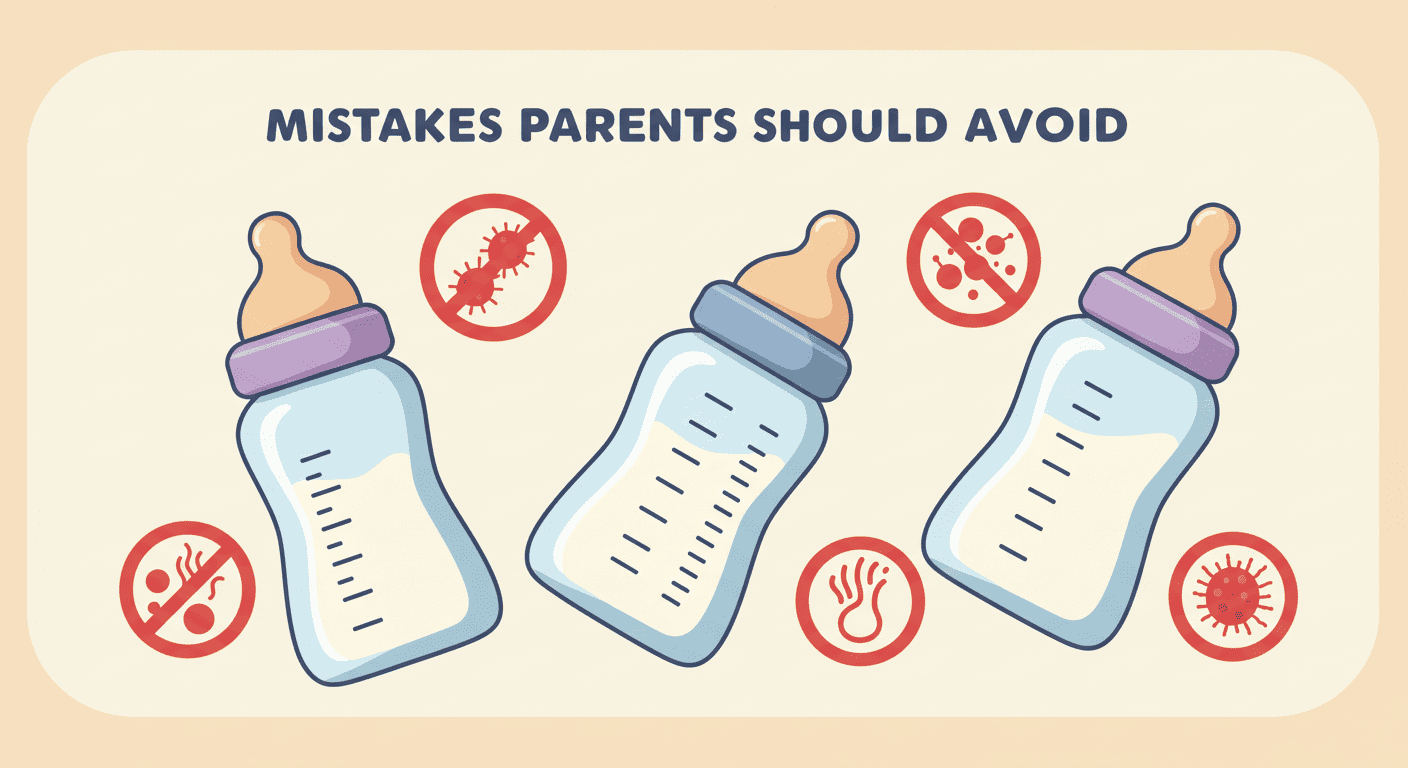
8. Mistakes Parents Should Avoid
Even the most caring parents can slip into habits that put their babies at risk. By avoiding these common mistakes, you protect your child from unnecessary exposure to plastic toxins.
8.1 Using Harsh Chemicals
Many parents think bleach or strong disinfectants guarantee cleanliness. In reality, these products can damage plastic, leave residues, and react with milk. Always stick to baby-safe cleaners.
8.2 Leaving Bottles Dirty for Hours
Milk residue breeds bacteria quickly. Don’t let bottles sit in the sink until the end of the day. Rinse and wash them as soon as possible after each feeding.
8.3 Heating Formula Directly in Plastic Bottles
Pouring boiling water or heating formula inside a plastic bottle speeds up chemical leaching. Use a separate heat-safe container, let the liquid cool, and then transfer it into the bottle.
8.4 Overusing the Dishwasher
Dishwashers with high heat and strong detergents wear down bottles faster. If you use a dishwasher, choose the top rack and a gentle cycle. Hand-washing remains the safest method for minimizing microplastic release.
8.5 Ignoring Scratches and Wear
Once a bottle gets scratched or cloudy, it’s no longer safe. Micro-cracks trap bacteria and release more toxins. Replace bottles at the first signs of damage.
9. Frequently Asked Questions (FAQ)
Parents often ask the same questions when it comes to cleaning bottles safely. Here are clear, practical answers based on science and best practices.
Q1. Is vinegar safe for cleaning baby bottles?
Yes, when diluted properly. Mix 1 part white vinegar with 3 parts water and soak bottles for 15–20 minutes. Rinse thoroughly afterward to remove any sour taste or smell.
Q2. How often should I sterilize baby bottles?
For newborns, aim to sterilize bottles at least once a day. As your baby grows and their immune system strengthens, daily sterilization becomes less critical, but a weekly deep clean is still recommended.
Q3. Can I safely wash plastic bottles in the dishwasher?
Yes, but only on the top rack with a gentle cycle. Avoid high-heat drying, which speeds up plastic degradation. Hand washing remains the safest option to minimize microplastic shedding.
Q4. Are BPA-free bottles 100% toxin-free?
Not necessarily. While BPA is banned in baby bottles in the U.S., similar compounds like BPS and BPF may still pose risks. This is why safe cleaning methods and alternatives like glass or stainless steel matter.
Q5. What’s the safest bottle material for my baby?
Glass and stainless steel are the safest options because they don’t leach toxins. Silicone can also be safe if it’s medical-grade and FDA-approved.
Conclusion: A Safer Feeding Routine for Your Baby
Keeping your baby safe starts with the smallest daily choices — including how you clean their bottles. Now you know exactly how to clean baby bottles without plastic toxins:
-
Use gentle, non-toxic cleaners like baking soda, vinegar, or baby-safe dish soap.
-
Follow a step-by-step daily routine with warm water, soft brushes, and natural drying.
-
Commit to a weekly deep clean with safe sterilization methods that don’t break down plastics.
-
Avoid common mistakes such as heating formula inside plastic bottles or using harsh chemicals.
-
Consider switching to glass, stainless steel, or silicone bottles for the ultimate toxin-free solution.
By following these practices, you minimize your baby’s exposure to harmful chemicals while keeping bottles hygienic and safe. The payoff is peace of mind — every feeding becomes one less thing to worry about.
✨ Remember: consistency matters more than perfection. With the right routine, you’ll protect your baby’s health today and set a strong foundation for the future.
Share this content:
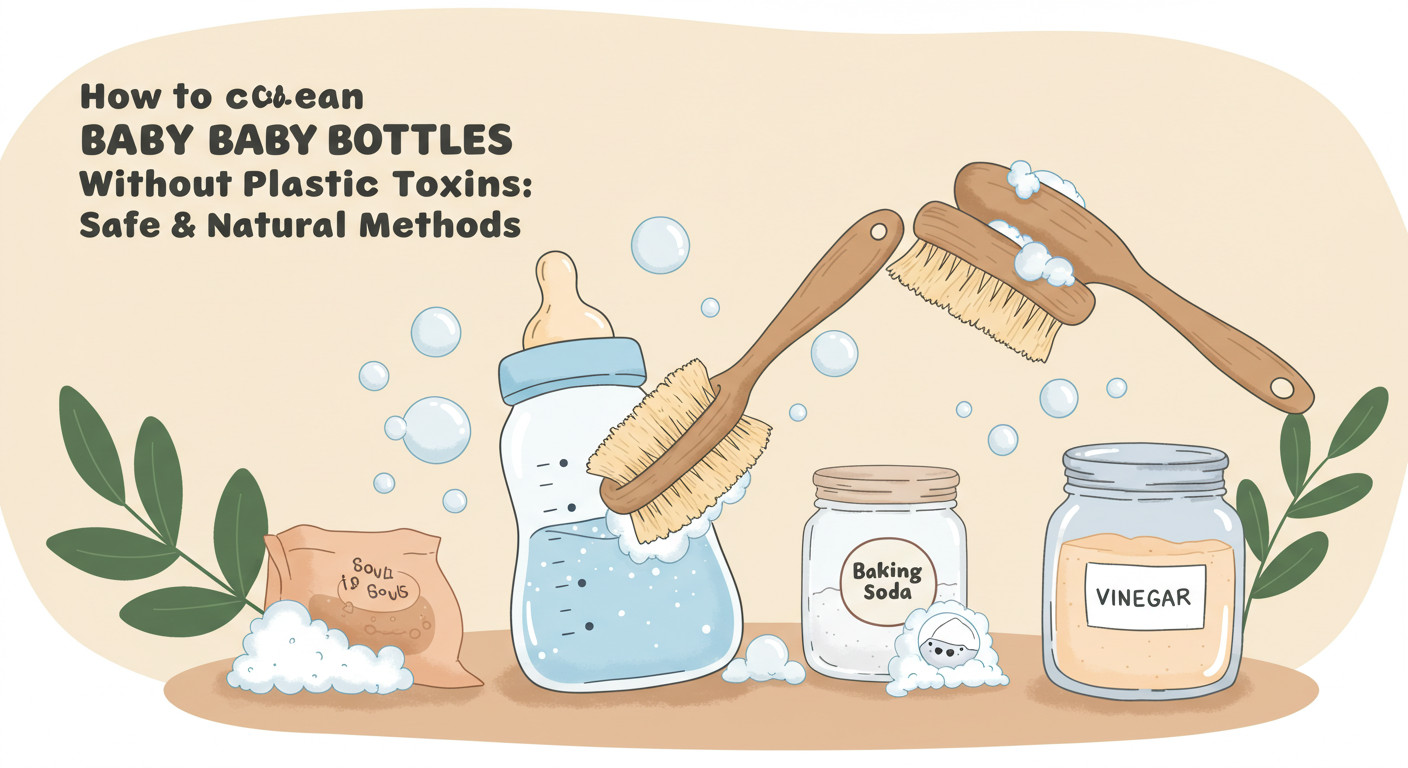
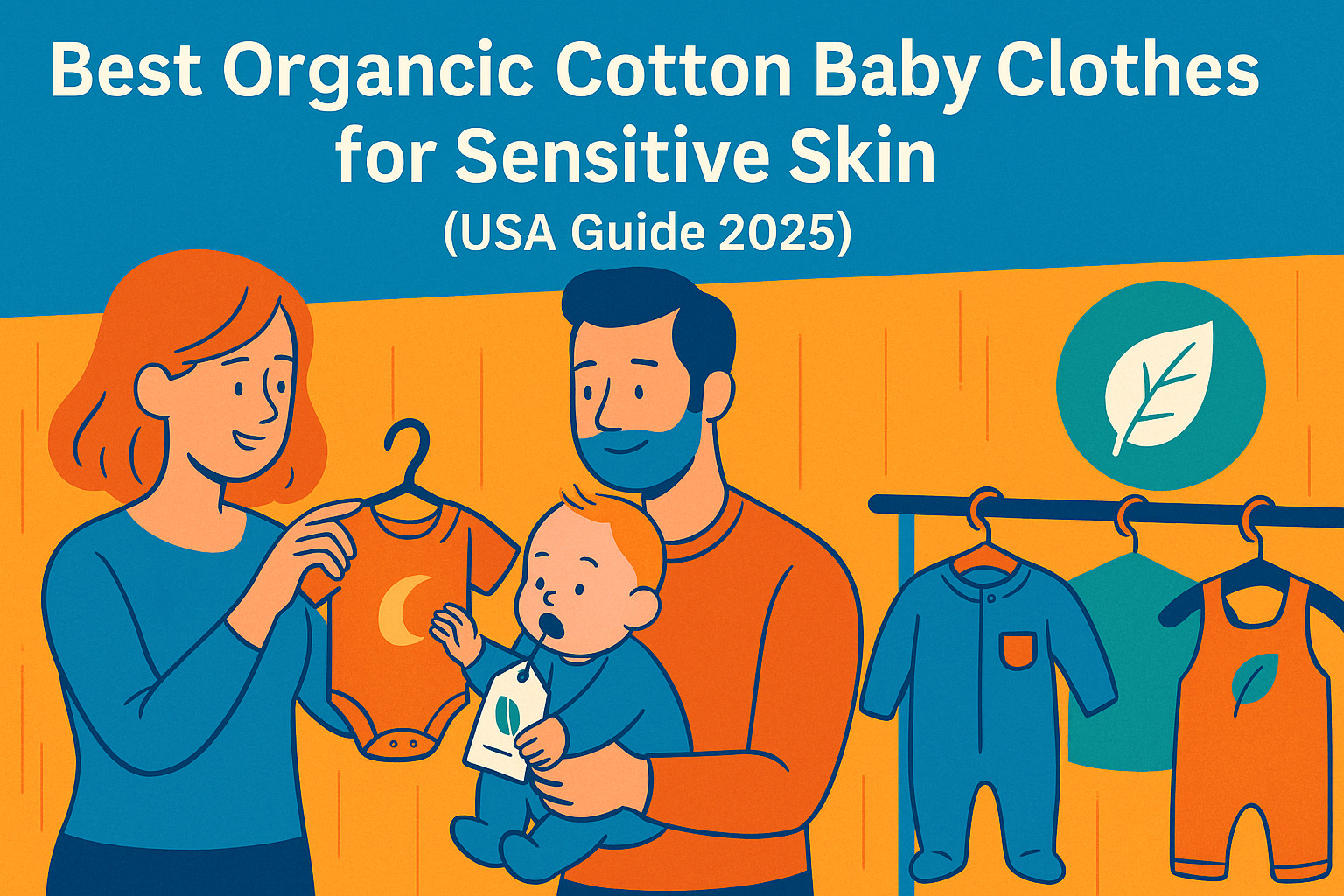
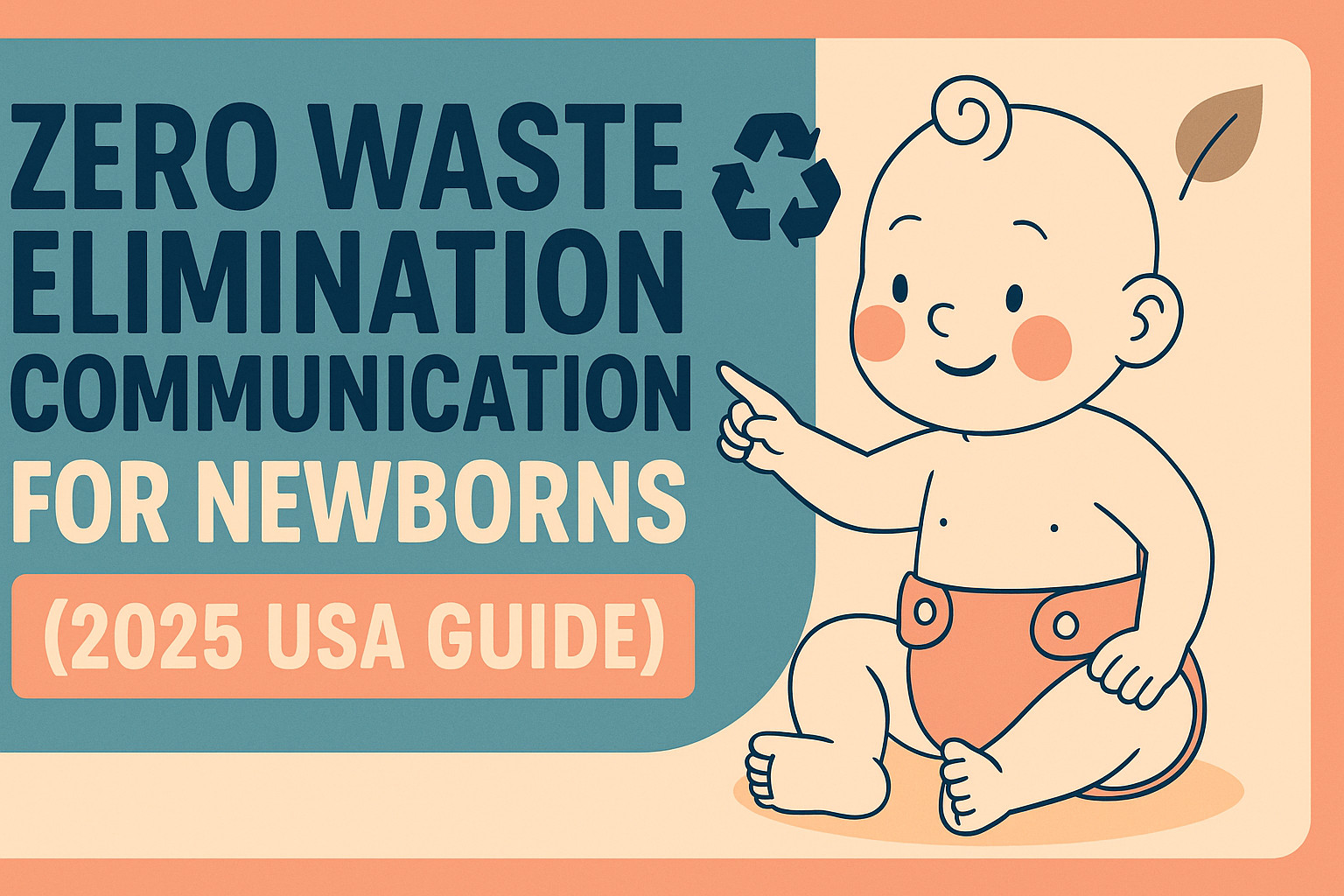
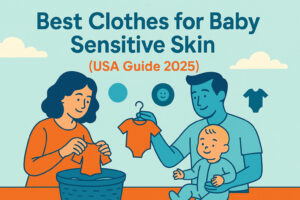
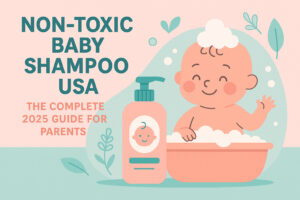
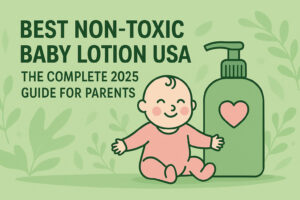

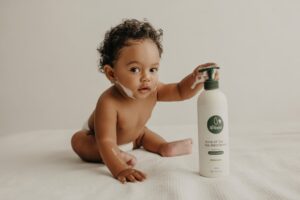
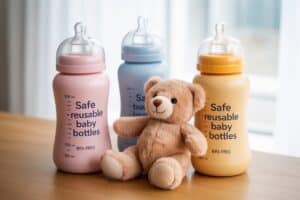
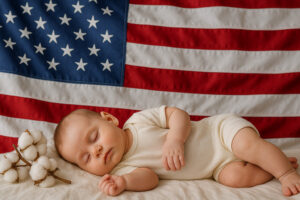
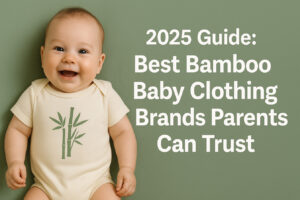
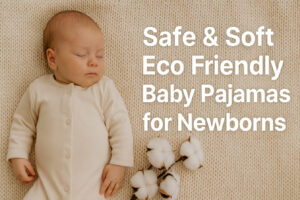
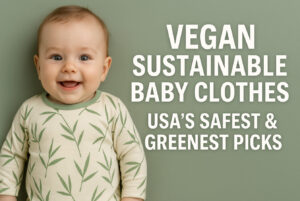
Post Comment